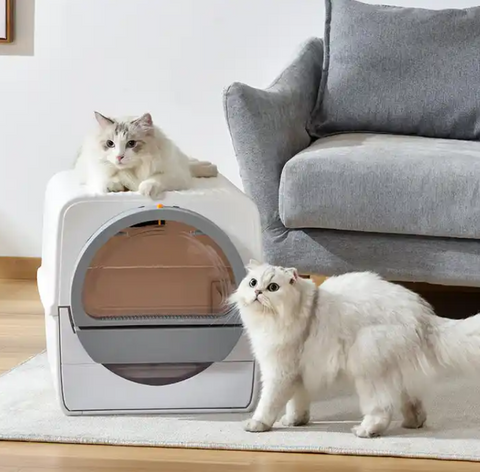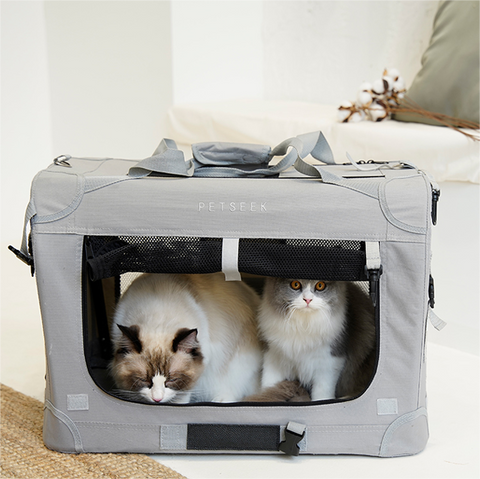
Please keep this complete guide to pet neutering!
Please keep this complete guide to pet neutering!
Neutering time:
It is recommended that cats and dogs be neutered (castrated) at 6 to 8 months of age. It is recommended that females be sterilized before their first estrus to better prevent breast tumors. For males, it is also recommended that males be sterilized in time after sexual and physical maturity to avoid developing bad behaviors, such as wandering or fighting in the pursuit of love. . In terms of specific time, as long as the post-operative care is proper and the female avoids estrus, she can be sterilized or castrated. There is no saying that "a certain season is more suitable for sterilization".

Things to note before sterilization:
Make sure that dogs and cats have been vaccinated and dewormed regularly, their antibody levels are acceptable, and there are no abnormal symptoms recently. Choose a regular animal hospital and consult in advance to learn about surgical anesthesia methods, costs and other information. After choosing an animal hospital, call to inform your furry child of its age, immunization and deworming status, and make an appointment. At the same time, the hospital will inform you of some preoperative precautions in advance, especially the time of fasting and fasting before surgery.
After the surgery time is scheduled, parents and furry children can make some preliminary preparations. If the cat is afraid of going to the hospital, parents can prepare a comfortable flight box in advance and train the cat to go out. Some cat parents are also worried about the discomfort caused by wearing an Elizabethan ring and the female cat wearing a surgical gown after surgery. You can also prepare in advance to familiarize them with Elizabethan rings and surgical gowns. These methods are also suitable for timid and stress-prone dogs.

If your dog has a regular bathing habit, you can take a bath 3 days before surgery. Before the surgery, remember to keep your furry dog from eating and drinking on time, usually 6 to 8 hours. The specific time should follow the doctor’s instructions when booking the surgery. On the day of surgery, bring your furry child's usual blanket to the hospital and cover it with them during their recovery period. This will not only help maintain body temperature, but will also make them feel more secure.
Preoperative examination:
After arriving at the hospital, the doctor will also conduct relevant preoperative examinations for the furry child. Because furry babies are very tolerant and won’t say what’s wrong with them, looking healthy doesn’t mean there are no potential risks. Preoperative examinations are very important! Generally, furry children will be given routine blood tests and biochemical tests to confirm the pet's basic physical condition. Based on the pet's condition, it will also be decided whether to conduct screening for heart disease, infectious diseases, etc.

Surgical procedure:
After the furry children pass the preoperative examination, intravenous indwelling needles will be embedded in them to facilitate administration before, during, and after surgery and in emergency situations. Before the operation, the doctor will choose to give it preoperative fluid rehydration, inject painkillers, hemostatics, sedatives, etc. based on the furry child's condition.
Most animal hospitals now choose respiratory anesthesia, which is safer and more stable than simple injection anesthesia. If you choose respiratory anesthesia, after entering the operating room, anesthesia will be induced by intravenous injection, and then tracheal intubation will be performed. At the same time, professional instruments will be used to monitor the fur baby's blood pressure, breathing, heart rate and other physical indicators. In this way, the anesthesia plan can be adjusted in time, and abnormalities can be detected in time.
Neutering a female pet requires making an incision in the abdomen and removing the uterus and ovaries. The operation usually takes about an hour. Normally developing male pets usually need to make an incision on the scrotum to remove the testicles and epididymis. The operation usually can be completed in about 40 minutes.
Postoperative care:
After the furry baby comes out of the operating room, he is not fully awake yet, and it usually takes more than 30 minutes to fully wake up. During this period, parents can bring a small blanket to cover it to help restore its body temperature. It has a familiar smell and makes it feel more secure. It is also necessary to refrain from food and water for 4 to 8 hours after surgery to avoid vomiting and digestive disorders.
After taking your furry child home, if the doctor has prescribed post-operative oral medication, you should give it to your furry child on time to help them recover as soon as possible. At the same time, exercise should be restricted to avoid wound cracking. Keep the wound clean and dry, and wear an Elizabethan collar. Female pets generally need to wear surgical gowns to avoid licking the wound and causing infection. Because the surgical suture methods and sutures used are different, it also determines whether the sutures need to be removed later. As long as you follow the doctor's instructions, communicate with the doctor at any time, and follow up with the doctor on time, you will be fine.

Sterilization surgery may be the first and only surgery that many furry children undergo in their lives. Some parents are also very confused about whether to have sterilization or not. Are they afraid of the risks of anesthesia? Worried about surgical pain? Do you think you will gain weight after sterilization? In fact, from the perspective of the health of furry children, the benefits of age-appropriate neutering outweigh the disadvantages. Anesthesia risks and surgical pain can be avoided through good preoperative examination and perioperative management.
In fact, in the process of raising a pet, rather than worrying too much about yourself, it is better to consult professionals to learn relevant knowledge and precautions. Raising pets scientifically is the best love for furry children...
It is recommended that cats and dogs be neutered (castrated) at 6 to 8 months of age. It is recommended that females be sterilized before their first estrus to better prevent breast tumors. For males, it is also recommended that males be sterilized in time after sexual and physical maturity to avoid developing bad behaviors, such as wandering or fighting in the pursuit of love. . In terms of specific time, as long as the post-operative care is proper and the female avoids estrus, she can be sterilized or castrated. There is no saying that "a certain season is more suitable for sterilization".

Things to note before sterilization:
Make sure that dogs and cats have been vaccinated and dewormed regularly, their antibody levels are acceptable, and there are no abnormal symptoms recently. Choose a regular animal hospital and consult in advance to learn about surgical anesthesia methods, costs and other information. After choosing an animal hospital, call to inform your furry child of its age, immunization and deworming status, and make an appointment. At the same time, the hospital will inform you of some preoperative precautions in advance, especially the time of fasting and fasting before surgery.
After the surgery time is scheduled, parents and furry children can make some preliminary preparations. If the cat is afraid of going to the hospital, parents can prepare a comfortable flight box in advance and train the cat to go out. Some cat parents are also worried about the discomfort caused by wearing an Elizabethan ring and the female cat wearing a surgical gown after surgery. You can also prepare in advance to familiarize them with Elizabethan rings and surgical gowns. These methods are also suitable for timid and stress-prone dogs.

If your dog has a regular bathing habit, you can take a bath 3 days before surgery. Before the surgery, remember to keep your furry dog from eating and drinking on time, usually 6 to 8 hours. The specific time should follow the doctor’s instructions when booking the surgery. On the day of surgery, bring your furry child's usual blanket to the hospital and cover it with them during their recovery period. This will not only help maintain body temperature, but will also make them feel more secure.
Preoperative examination:
After arriving at the hospital, the doctor will also conduct relevant preoperative examinations for the furry child. Because furry babies are very tolerant and won’t say what’s wrong with them, looking healthy doesn’t mean there are no potential risks. Preoperative examinations are very important! Generally, furry children will be given routine blood tests and biochemical tests to confirm the pet's basic physical condition. Based on the pet's condition, it will also be decided whether to conduct screening for heart disease, infectious diseases, etc.

Surgical procedure:
After the furry children pass the preoperative examination, intravenous indwelling needles will be embedded in them to facilitate administration before, during, and after surgery and in emergency situations. Before the operation, the doctor will choose to give it preoperative fluid rehydration, inject painkillers, hemostatics, sedatives, etc. based on the furry child's condition.
Most animal hospitals now choose respiratory anesthesia, which is safer and more stable than simple injection anesthesia. If you choose respiratory anesthesia, after entering the operating room, anesthesia will be induced by intravenous injection, and then tracheal intubation will be performed. At the same time, professional instruments will be used to monitor the fur baby's blood pressure, breathing, heart rate and other physical indicators. In this way, the anesthesia plan can be adjusted in time, and abnormalities can be detected in time.
Neutering a female pet requires making an incision in the abdomen and removing the uterus and ovaries. The operation usually takes about an hour. Normally developing male pets usually need to make an incision on the scrotum to remove the testicles and epididymis. The operation usually can be completed in about 40 minutes.
Postoperative care:
After the furry baby comes out of the operating room, he is not fully awake yet, and it usually takes more than 30 minutes to fully wake up. During this period, parents can bring a small blanket to cover it to help restore its body temperature. It has a familiar smell and makes it feel more secure. It is also necessary to refrain from food and water for 4 to 8 hours after surgery to avoid vomiting and digestive disorders.
After taking your furry child home, if the doctor has prescribed post-operative oral medication, you should give it to your furry child on time to help them recover as soon as possible. At the same time, exercise should be restricted to avoid wound cracking. Keep the wound clean and dry, and wear an Elizabethan collar. Female pets generally need to wear surgical gowns to avoid licking the wound and causing infection. Because the surgical suture methods and sutures used are different, it also determines whether the sutures need to be removed later. As long as you follow the doctor's instructions, communicate with the doctor at any time, and follow up with the doctor on time, you will be fine.

Sterilization surgery may be the first and only surgery that many furry children undergo in their lives. Some parents are also very confused about whether to have sterilization or not. Are they afraid of the risks of anesthesia? Worried about surgical pain? Do you think you will gain weight after sterilization? In fact, from the perspective of the health of furry children, the benefits of age-appropriate neutering outweigh the disadvantages. Anesthesia risks and surgical pain can be avoided through good preoperative examination and perioperative management.
In fact, in the process of raising a pet, rather than worrying too much about yourself, it is better to consult professionals to learn relevant knowledge and precautions. Raising pets scientifically is the best love for furry children...
Shop the story
